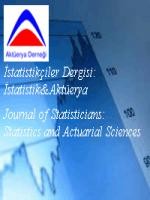Türkiye’deki Đssizlik Oranının Bulanık Doğrusal Regresyon Analiziyle Tahmini
Gelismis ve gelismekte olan ülkelerde karsılasılan en önemli problemlerden biri olan issizlik sorunu Türkiye
Anahtar Kelimeler:
Bulanık Doğrusal Regresyon Analizi, Bulanık Hipotez Testi, Đssizlik.
Estimation of Unemployment Rate in Turkey by Fuzzy Linear Regression Analysis
Unemployment rate is one of the most important problems that encountered in developed and developingcountries. It is also appeared to be a multi-faceted problem that affects Turkey's economy in the economic andsocial areas of each period. Unemployment rate, that our country is struggling with for a long time, is reportedas %9.8 according to official figures. Unemployment rate is a multi-dimensional problem. Thus, it may resultin misleading conclusions if it is only associated with economic growth or be handled alone when solving thisproblem. Fuzzy regression analysis is a method that relationships between variables are not established withclear boundaries and the reliability of data sources is decreased. Reliable estimates are obtained by usingfuzzy regression model. In this study, estimation of unemployment rate which is an important indicator of thelevel of social development of our country is estimated by using two different fuzzy regression estimationmethods. Also fuzzy hypothesis testing is done for the coefficients obtained from the fuzzy regression model andresults are interpreted.
___
- M. A. Basaran, 2007, Çok Değiskenli Bulanık Regresyonda Parametre Tahmini, Hacettepe Üniversitesi, Fen Bilimleri Enstitüsü, Ankara, Doktora Tezi.
- C. Bekiroğlu, 2010, Türkiye’de Đssizlik Sorununun Çözümlenmesinde Uygulanan Ekonomi Politikalarının Analizi, Kadir Has Üniversitesi, Sosyal Bilimler Enstitüsü, Finans Bankacılık Yüksek Lisans Programı, Đstanbul, Yüksek Lisans Tezi.
- U. Y. Bozdağlıoğlu, 2008, Türkiye’de Đssizliğin Özellikleri ve Đssizlikle Mücadele Politikaları, Kırgızistan- Türkiye Manas Üniversitesi, Sosyal Bilimler Dergisi, 20, 45-65.
- J. J. Buckley, 2004, Fuzzy Statistics, Springer, Germany.
- J. J. Buckley, 2005, Fuzzy statistics: regression and prediction, Soft Comput, 9, 769-775.
- J. J. Buckley, 2006, Fuzzy Probability and Statistics, Springer, Netherlands.
- Y. H. O. Chang, B. M. Ayyub, 2001, Fuzzy regression methods a comparative assessment, Fuzzy Sets and Systems, 119, 187-203.
- P. Diamond, 1988, Fuzzy Least Squares, Information Sciences, 46, 141-157.
- N. A. Erilli, M. K. Körez, Y. Öner, K. Alakus, 2012, Kritik (kriz) Dönem Enflasyon Hesaplamalarında Bulanık Regresyon Tahminlemesi, Doğus Üniversitesi Dergisi, 13 (2), 239-253.
- B. Y. Eser, H. Terzi, 2008, Türkiye’de issizlik sorunu ve Avrupa istihdam stratejisi, Erciyes Üniversitesi Đktisadi ve Đdari Bilimler Fakültesi Dergisi, 30, 229-250.
- A. Göktas, Ö. Đsçi, 2010, Türkiye’de Đssizlik Oranlarının Temel Bilesenli Regresyon Analizi ile Belirlenmesi, Selçuk Üniversitesi, Đktisadi ve Đdari Bilimler Fakültesi, Sosyal ve Ekonomik Arastırmalar Dergisi, 14 (20), 279-294.
- A. Hepsağ, 2009, Türkiye'de Enflasyon ile Đssizlik Arasındaki Đliskinin Analizi: Sınır Testi Yaklasımı, Đktisat Fakültesi Mecmuası, 59 (1), 169-190.
- D. Đçen, 2010, Bulanık Doğrusal Regresyon Analizi, Hacettepe Üniversitesi, Fen Bilimleri Enstitüsü, Ankara, Yüksek Lisans Tezi.
- C. Kahraman, A. Beskese, F. T. Bozbura, 2006, Fuzzy regression approaches and applications, StudFuz, 201, 589-615.
- F. Ç. Karaali, F. Ülengin, 2008, Yapay Sinir Ağları ve bilissel haritalar kullanılarak issizlik oranı öngörü çalısması, ĐTÜ dergisi/d, 7 (3), 15-26.
- O. Mikhail, C. J. Eberwein, J. Handa, 2003, The Measurement of Persistence and Hysteresis in Aggregate Unemployment, [erisim adresi]: http://128.118.178.162/eps/mhet/papers/0311/0311002.pdf [erisim tarihi: 13.09.2013].
- H. Moskowitz, K. Kim, 1993, On assessing the H value in fuzzy linear regression, Fuzzy Sets and Systems, 58, 303-327.
- OECD, 2013, [erisim adresi]: http://stats.oecd.org/Index.aspx?DatasetCode=STLABOUR# [erisim tarihi: 01.10.2013].
- A. Oğuzlar, 2007, Đssizliğe Etki Eden Değiskenlerin Medyan Parlatma Tekniğiyle Analizi, Atatürk Üniverstiesi Đktisadi ve Đdari Bilimler Dergisi, 21 (1), 103-117.
- H. Seyidoğlu, 1999, Ekonomik terimler, Güzem can yayınları, Đstanbul.
- A. F. Shapiro, 2005, Fuzzy Regression Models, Penn State University, USA [erisim adresi]: http://www.soa.org/library/research/actuarial-research-clearing-house/2006/january/arch06v40n1-ii.pdf, [erisim tarihi: 13.12.2012].
- K. Tanaka, S. Uejima, K. Asai, 1982, Linear regression analysis with fuzzy model, IEEE, 12 (6), 903-907.
- T.C. Devlet Planlama Teskilatı, 2010, [erisim adresi]: http://ekutup.dpt.gov.tr/ueg/2009/2009.asp [erisim tarihi: 04.02.2010].
- C. I. Ucenic, A. George, 2008, Soft computing methods applied in forecasting of economic indices case study: forecasting of Greek unemployment rate using an artificial neural network with fuzzy inference system, MACMESE'08 Proceedings of the 10th WSEAS international conference on Mathematical and computational methods in science and engineering, 233-237.
- D. Uysal, S. Erdoğan, 2003, Enflasyon ve Đssizlik Oranı Arasındaki Đliski ve Türkiye Örneği (1980 – 2002), Selçuk Üniversitesi, Đktisadi ve Đdari Bilimler Fakültesi, Sosyal ve Ekonomik Arastırmalar Dergisi, 6, 35-47.
- H. F. Wang, R. C. Tsaur, 2000a, Insight of a fuzzy regression model, Fuzzy Sets and Systems, 112, 355-369.
- H. F. Wang, R. C. Tsaur, 2000b, Resolution of fuzzy regression model, Europhean Journal of Operational Research, 126, 637-650.
- H. M. Yüceol, 2005, Bir Politika Değiskeni Olarak Đssizliğin Ölçülmesi Sorunu ve Türkiye’de Gerçek Đssizlik Oranı, Elektronik Sosyal Bilimler Dergisi, 3 (12), 118-133.
- Ö. G. Yılmaz, 2005, Türkiye ekonomisinde büyüme ile issizlik oranları arasındaki nedensellik iliskisi, Ekonometri ve Đstatistik, 2, 11-29.
- L. A. Zadeh, 1965, Fuzzy Sets, Information and Control, 8, 338-353.
- ISSN: 1308-0539
- Yayın Aralığı: Yılda 2 Sayı
- Başlangıç: 2008
- Yayıncı: Aktüerya Derneği
